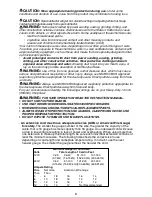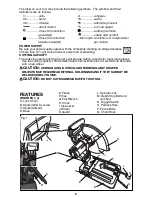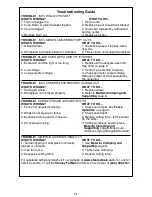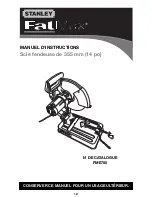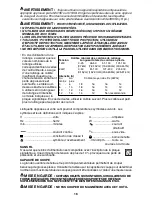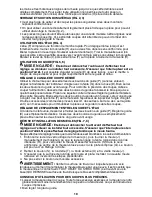
3
gloves away from moving parts.
Loose clothes, jewelry or long hair can be caught in moving parts.
g)
If devices are provided for the connection of dust extraction and collection facilities,
ensure these are connected and properly used.
Use of dust collection can reduce dust-
related hazards.
4) POWER TOOL USE AND CARE
a)
Do not force the power tool. Use the correct power tool for your application.
The correct
power tool will do the job better and safer at the rate for which it was designed.
b)
Do not use the power tool if the switch does not turn it on and off.
Any power tool that
cannot be controlled with the switch is dangerous and must be repaired
.
c)
Disconnect the plug from the power source and/or the battery pack from the power
tool before making any adjustments, changing accessories, or storing power tools.
Such
preventive safety measures reduce the risk of starting the power tool accidentally.
d)
Store idle power tools out of the reach of children and do not allow persons unfamiliar
with the power tool or these instructions to operate the power tool.
Power tools are
dangerous in the hands of untrained users.
e)
Maintain power tools. Check for misalignment or binding of moving parts, breakage of parts
and any other condition that may affect the power tool’s operation. If damaged, have the
power tool repaired before use.
Many accidents are caused by poorly maintained power tools.
f)
Keep cutting tools sharp and clean.
Properly maintained cutting tools with sharp cutting
edges are less likely to bind and are easier to control.
g)
Use the power tool, accessories and tool bits, etc. in accordance with these instructions,
taking into account the working conditions and the work to be performed.
Use of the power tool
for operations different from those intended could result in a hazardous situation.
5)
SERVICE
a)
Have your power tool serviced by a qualified repair person using only identical replacement
parts.
This will ensure that the safety of the power tool is maintained.
Additional Safety Rules for Chop Saws
• Always wear proper eye and respiratory protection.
•
Before using, inspect the cutting wheel for cracks or flaws. If such a crack or
flaw is evident, discard the wheel. The wheel should also be inspected whenever
you think the tool may have been dropped.
Flaws may cause wheel breakage.
• When starting the tool with a new or replacement wheel or if you are unsure of
the condition of the wheel, hold the tool in a well protected area and let it run for
one minute.
If the wheel has an undetected crack or flaw, it should burst in less than one
minute. Never start the tool with a person in line with the wheel. This includes the operator.
• In operation, avoid bouncing the wheel or giving it rough treatment.
If this occurs,
stop the tool and inspect the wheel for cracks or flaws.
• Clean your chop saw periodically following the procedure in this manual.
• Do not remove wheel guards or base.
•
ALWAYS USE THE VISE OR SPECIAL FIXTURE TO CLAMP WORK SECURELY.
Other aids such as spring, bar, or C-clamps may be appropriate for certain sizes and
shapes of workpiece. Use care in selecting and placing these clamps and make a dry
run before making a cut.
• Use only 14 in. (355mm) type 1 wheels rated at 4300 rpm or higher.
• Allow cut off parts to cool before handling.
• Do not attempt to cut wood or plastic with this tool.
•
NEVER CUT MAGNESIUM WITH THIS TOOL.
• Use chop saw in a well-ventilated area.
• Turn chop saw off before removing any pieces from the base.
•
DO NOT CUT ELECTRICALLY LIVE MATERIAL.
•
Do not use circular saw blades or any other toothed blades with this tool.
Serious injury may result.
•
DO NOT OPERATE THIS TOOL NEAR FLAMMABLE
LIQUIDS, GASES OR DUST.
Sparks or hot chips from cutting or arcing motor
brushes may ignite combustible materials.
• Do not use the side of the abrasive wheel as a deburring grinder. This will substantially
weaken the wheel creating an unsafe condition. The wheel may come apart.




